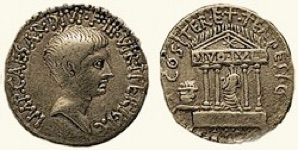Romans
Roman Temples: Temple of Divus Julius (Test Page)
Return to: Roman Temples Developments at Rome Home


Romans
Roman Temples: Temple of Divus Julius (Test Page)
Return to: Roman Temples Developments at Rome Home

IMP CAESAR DIVI F III·VIR ITER R P C/ DIVO IVL - COS ITER ET TER DESIG (RRC 540/1, 36 BC)
Temple of Divus Julius depicted on the reverse
Mia: I have used wide interline spaces to separate the four paragraphs below, each with the text below (in a smaller, italicised font) for the associated box on the right. Obviously, this is just for your convenience. Please feel free to mess about with fonts, title styles, line spacings etc so that the design is optimised from you perspective.
I have put temporary links between this page and my presnt page in the box at the bottom, for our convenience.
As everyone knows, Julius Caesar was assassinated on the ides of March, 44 BC. Immediately after his funeral, his body was cremated in the forum and an altar was erected on the spot. Cassius Dio* recorded that, on the first day of 42 BC, the triumvirs Mark Antony, Lepidus and Octavian, laid the foundations of a shrine on this spot, dedicated to Caesar ‘as hero’. In other words, the temple was dedicated to the deified Julius Caesar, named as divus Julius.
Ancient Sources (*)
Cassius Dio
“[The triumvirs] laid the foundation of a shrine to Caesar, as hero, in the Forum, on the spot where his body had been burned”, (‘Roman History’, 47: 18: 4).
Darryl Phillips** pointed out that a coin series (RRC 540/1 and 540/2), which was issued at the time of Octavian’s major naval victory over Sextus Pompeius at Naulochus in 36 BC, provides our first glimpse of the structure of this temple. The obverse designs of the coins featured the temple itself, clearly designated by the words ‘DIVO IVL’ on the architrave. Furthermore:
-a cult statue (presumably of Caesar) stands between the temple columns;
-the sidus Iulium, the star or comet that had proclaimed his apotheosis during the Ludi Veneris Genitricis of 44 BC, is represented in the pediment; and
-an altar (presumably the altar to divus Julius that had been erected in the forum in 44 BC to mark his cremation) is shown to the left of the temple.
Philips suggested that the issue of these coins may have commemorated the start of the construction of the temple.
References (**)
Phillips D, 2011, at p. 376
After Naulochus, although the triumvirate was still notionally in existence, Mark Antony administered the eastern part of the Roman state from Alexandria, Lepidus lived in exile, and Octavian administered the western part of the state from Rome. Relations between Octavian and Mark Antony soon began to deteriorate, and they broke down irretrievably in 34 BC. This led to Octavian’s war, which was officially declared only on Cleopatra, and Octavian’s famous naval victory over Mark Antony at Actium in 31 BC. Cassius Dio* recorded that:
-among the marks of honour that were awarded to Octavian while he was still in the east, the foundation of the shrine of Julius’ (presumably the temple of Divus Julius) was decorated with the beaks of the ships captured at Actium (at 51: 19); and
-immediately after his return in 29 BC and the celebration of his triple triumph (on August 13th-15th, for his victories in Dalmatia, at Actium and in Egypt respectively), the temple of Divus Julius was consecrated and some of the spoils of the war in Egypt were placed in it (at 51: 22).
The fasti Antiates and the fasti Amiternini record the dies natalis of the temple of Divus Julius in the forum as 18th August. Thus it seems that it had served as one of the loci for the celebration of Octavian’s victories, and that, although it had long been planned, it was essentially built using the spoils of the wars of 31 BC.
Ancient Sources (*)
Cassius Dio
“[While Octavian was engaged against Mark Antony in the east], the Romans at home had passed many resolutions in honour of his naval victory [at Actium]. Thus, they granted him a triumph, as if over Cleopatra [rather than Mark Antony], an arch adorned with trophies at Brundisium, and another in the Roman forum. Moreover, they decreed that the foundation of the shrine of [divus] Julius should be adorned with the beaks of the captured ships ... ”, (‘Roman History’, 51: 19: 1-2).
“... the shrine of [divus] Julius ... was consecrated [immediately after Octavian’s triple triumph of 29 BC, and some of the spoils of war in Egypt] were placed in it ...”, (‘Roman History’, 51: 22: 3).
Darryl Phillips** also noted the links between Octavians’ temple of Divus Julius and Caesar’s temple Venus Genetrix:
-Vitruvius* named only two Roman examples of temples of the pycnostyle type (which was characterised by close-set columns(: Octavian’s temple of Divus Julius in the forum, and the temple of Venus Genetrix in the forum Caesaris; and
-just as Caesar had dedicated the temple of Venus Genetrix in connection with the celebration of his quadruple triumph in 46 BC, so Octavian dedicated the temple of Divus Julius after his triple triumph in 29 BC.
Ancient Sources (*)
Vitruvius
“The pycnostyle is a temple in an intercolumniation of which the thickness of a column and a half can be inserted: for example, the temple of the Divine Caesar; and that of Venus in Caesar's forum, and others constructed like them”, (‘Ten Books on Architecture’, 3: 3: 2).
References (**)
Phillips D, 2011, at p. 382
Read more:
Phillips D., “The Temple of Divus Iulus and the Restoration of Legislative Assemblies under Augustus”, 65:3-4 (2011) 371-92
Temporary link to present page
Return to Temples
Return to Romans